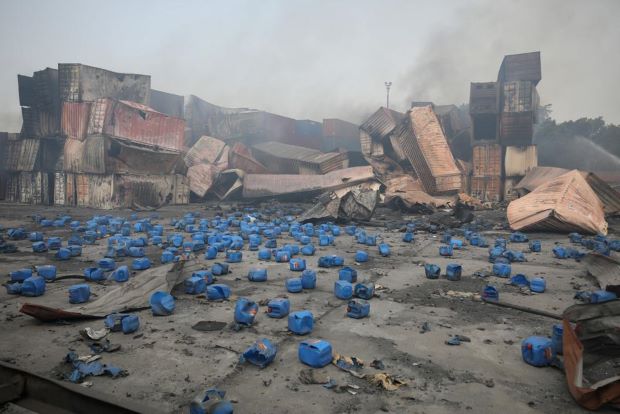Firefighters unaware of chemicals at Bangladesh depot, official says
By Saif Hasnat and Emily Schmall
SITAKUNDA— Firefighters who suffered heavy casualties while responding to a blaze at a shipping container depot in southern Bangladesh over the weekend were unaware of the presence of chemical drums, which set off a series of powerful explosions, local authorities said.
At least 49 people were killed, including nine firefighters, and hundreds more suffered burns in the fire and subsequent explosions, which sent a booming noise over the landscape and shattered windows of nearby buildings. Among those killed were residents who approached the site to capture the fire with their phones.
The disaster reflected the haphazard safety standards that continue to dog Bangladesh, particularly its lucrative garment export industry. The depot held clothing ready for export as well as drums filled with hydrogen peroxide, a chemical compound often used to bleach and dye fabric.
For more than 48 hours after the fire began, pungent, noxious smoke streamed from the BM Inland Container Depot, a Dutch-Bangladeshi venture, in the town of Sitakunda, about 10 miles from Chattogram, Bangladesh’s main port. By Tuesday (7), the fire was under control, Ariful Islam, a Bangladeshi military official who was investigating the disaster, told reporters.
“A specialist army team has reached the spot to check if there is anything dangerous remaining at the depot,” he said.
As the smoke cleared, a tableau of ruin emerged: mountains of ash, crumpled tin sheds, charred shipping containers and blasted plastic chemical drums. Rakibul Alam Chowdhury, a spokesman for the Bangladesh Garment Manufacturers and Exporters Association, estimated about $100 million in losses.
The initial cause of the fire remained unclear, authorities said. Those overseeing the depot had improperly stored the containers of hydrogen peroxide, said Monir Hossain, an assistant director at the Bangladesh Fire Service and Civil Defence who is part of the investigation.
He added that it was not known whether other potentially hazardous chemicals remained at the site.
While hydrogen peroxide itself is not flammable, the chemical can produce large quantities of oxygen and “could be explosive if it comes into contact with extreme heat or fire,” said Pradip Kumar Bakshi, a chemistry professor at the University of Dhaka, in Bangladesh’s capital.
It was unclear how many people were at the site when the fire began Saturday evening, but several employees of the depot said around 500 people would have been working the night shift. Authorities said Sunday that 49 people had died but revised the death toll down Monday.
Authorities said that there were more than 1,400 containers at the depot, spanning more than 50 acres, where the fire and subsequent explosions broke out, and could confirm that at least 26 containers held flammable goods, including chemicals.
BM Container Depot Ltd. said in a statement on its website that it was “shocked by the humanitarian catastrophe,” and that it had informed the fire department about the chemical cargo after the fire broke out and before the series of explosions.
A fire official, however, denied the department’s having any prior knowledge of the chemicals.
“When our first team arrived here to douse the fire, the authority did not tell them about the chemical inside. If they had said so earlier, there would not have been so many deaths,” said Purna Chandra, a national fire department official.
Firefighters said they had followed their training in rushing to the scene.
“Whenever we hear about a fire, we don’t think but douse the fire and save people’s lives,” said Mohammad Sojib, 24, a firefighter who was at the depot. The loss of fellow firefighters, he said, “was so devastating for us.”
Asaduzzaman Khan Kamal, Bangladesh’s home minister, traveled to the site Monday but did not answer questions.
Authorities said it would take at least a month to collect and analyze DNA samples from the ruins to identify those killed in the disaster.
Hundreds of family members of the injured gathered at the burn unit of Chattogram Medical College Hospital, as volunteer groups handed out food and medicine and ran a blood drive.
“My son Jamirul Islam is burned so badly,” said the mother of one depot employee, Rasheda Begum. “His back and hip are badly burned, and he cannot see with one eye.”
Mass-casualty fires and industrial disasters, particularly in garment factories, which account for 80% of the country’s exports, have been a recurring problem in Bangladesh.
The steady economic growth of the country of 170 million people has been a regional success story in recent years, but human rights and labour organizations have long expressed concern about the poor working conditions and inadequate workplace safety measures.
“This incident illustrates the urgent need to ensure proper handling and storage of chemicals, proper training for storage facility staff at awareness and operational levels, and effective crowd control during an emergency,” the International Labour Organization, a UN agency charged with setting labor standards worldwide, said in a statement.
A fire in a house illegally storing chemicals in the oldest part of the capital, Dhaka, killed at least 123 people in 2010.
In 2012, another fire raced through a garment factory on the outskirts of Dhaka, killing at least 112 people trapped behind its locked gates.
The worst of the disasters happened in 2013, when the collapse of an eight-story garment factory killed more than 1,100 people.
Authorities in Bangladesh imposed tougher safety rules after the 2013 disaster. But continuing corruption and lax enforcement have resulted in many more deaths from safety lapses, including a factory fire in July in the city of Narayanganj that killed at least 51 people.
-New York Times


